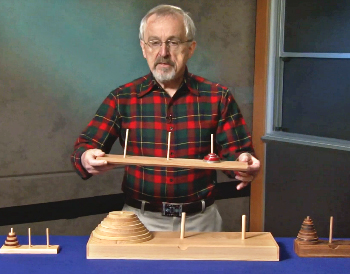


Make the legal move between pegs A and C (in either direction),.Make the legal move between pegs A and B (in either direction),.Doing this will complete the puzzle in the fewest moves. When the turn is to move the non-smallest piece, there is only one legal move. For example, if you started with three pieces, you would move the smallest piece to the opposite end, then continue in the left direction after that. If there is no tower position in the chosen direction, move the piece to the opposite end, but then continue to move in the correct direction. When moving the smallest piece, always move it to the next position in the same direction (to the right if the starting number of pieces is even, to the left if the starting number of pieces is odd). Iterative solution Īnimation of an iterative algorithm solving 6-disk problemĪ simple solution for the toy puzzle is to alternate moves between the smallest piece and a non-smallest piece. This is precisely the n th Mersenne number without primality requirements. The minimal number of moves required to solve a Tower of Hanoi puzzle is 2 n − 1, where n is the number of disks. The puzzle can be played with any number of disks, although many toy versions have around 7 to 9 of them. In some versions, other elements are introduced, such as the fact that the tower was created at the beginning of the world, or that the priests or monks may make only one move per day. The temple or monastery may be in various locales including Hanoi, and may be associated with any religion. For instance, in some tellings, the temple is a monastery, and the priests are monks. There are many variations on this legend. If the legend were true, and if the priests were able to move disks at a rate of one per second, using the smallest number of moves, it would take them 2 64 − 1 seconds or roughly 585 billion years to finish, which is about 42 times the current age of the universe. But, this story of Indian Kashi Vishwanath temple was spread tongue-in-cheek by a friend of Édouard Lucas Numerous myths regarding the ancient and mystical nature of the puzzle popped up almost immediately, including a myth about an Indian temple in Kashi Vishwanath containing a large room with three time-worn posts in it, surrounded by 64 golden disks. The puzzle was invented by the French mathematician Édouard Lucas in 1883. With 3 disks, the puzzle can be solved in 7 moves. No disk may be placed on top of a disk that is smaller than it.Each move consists of taking the upper disk from one of the stacks and placing it on top of another stack or on an empty rod.The objective of the puzzle is to move the entire stack to the last rod, obeying the following rules: The puzzle begins with the disks stacked on one rod in order of decreasing size, the smallest at the top, thus approximating a conical shape. The Tower of Hanoi (also called The problem of Benares Temple or Tower of Brahma or Lucas' Tower and sometimes pluralized as Towers, or simply pyramid puzzle ) is a mathematical game or puzzle consisting of three rods and a number of disks of various diameters, which can slide onto any rod. have this counter just to know how many times execute thisĬout (finish_time2 - init_time2 ).count() (finish_time2 - init_time2 ).Tower of Hanoi interactive display at Mexico City's Universum Museum Void hanoi_parallel(const int cant_disk, const char & first, const char & aux, const char & finish) I'm trying to make Hanoi towers works with OpenMP, but i feel that isn't working in such way that the task's are divided in each thread to make the process faster, this is my first time working with threads.


 0 kommentar(er)
0 kommentar(er)
